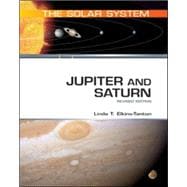
Jupiter and Saturn
by Linda T Elkins-TantonRent Textbook
New Textbook
We're Sorry
Sold Out
Used Textbook
We're Sorry
Sold Out
eTextbook
We're Sorry
Not Available
Summary
Author Biography
Table of Contents
| Foreword | p. vi |
| Preface | p. ix |
| Acknowledgments | p. xiv |
| Introduction | p. xv |
| Jupiter | |
| Jupiter: Fast facts about a Planet in Orbit | p. 3 |
| Fundamental Information about Jupiter | p. 5 |
| What Makes Gravity? | p. 9 |
| The Interior of Jupiter | p. 21 |
| Materials, Temperatures, and Pressures | p. 21 |
| Elements and Isotopes | p. 23 |
| What Is Pressure? | p. 27 |
| Magnetic Field | p. 30 |
| Radio Noise | p. 36 |
| Jupiter's Surface Appearance and Conditions | p. 38 |
| Remote Sensing | p. 40 |
| Optical Depth | p. 53 |
| Changes in Jupiter's Surface within Human History: Storms | p. 56 |
| Changes in Jupiter's Surface within Human History: Comet Shoemaker-Levy | p. 59 |
| Jupiter's Rings and Moons | p. 54 |
| The Surprise of Jupiter's Rings | p. 64 |
| Jupiter's Moons | p. 67 |
| What Are Synchronous Orbits and Synchronous Rotation? | p. 72 |
| Moment of Inertia | p. 94 |
| Rheology, or How Solids Can Flow | p. 106 |
| Missions to Jupiter | p. 111 |
| Saturn | p. 117 |
| Saturn: Fast Facts about a Planet in Orbit | p. 119 |
| Fundamental Information about Saturn | p. 121 |
| Saturn's Interior: Composition and Magnetic Field | p. 127 |
| Structure, Temperature, Pressure | p. 127 |
| Internal Heat Production | p. 128 |
| Magnetic Field | p. 129 |
| Saturn's Surface Appearance and Conditions | p. 133 |
| Saturn's Rings and Moons | p. 138 |
| Rings | p. 138 |
| Why Are There Rings? | p. 144 |
| Saturn's Moons | p. 150 |
| Giovanni Cassini (1625-1712) | p. 152 |
| Fossa, Sulci, and Other Terms for Planetary Landforms | p. 170 |
| Stable Orbits for Small Bodies among Much Larger Planets | p. 176 |
| Missions to Saturn | p. 195 |
| An Environment for Life? Titan, Enceladus, and Europa | p. 199 |
| Requirements for Life | p. 199 |
| Atmospheric Composition of the Early Earth | p. 201 |
| Water in Liquid Form | p. 202 |
| Organic Matter and Energy | p. 202 |
| Heat in the Environment | p. 204 |
| How Common Are These Conditions in the Formation of Planets? | p. 205 |
| Mars as the Early Earth Analog | p. 206 |
| Super Earths in Other Solar Systems | p. 206 |
| Icy Moons in Our Solar System | p. 207 |
| Detecting Life on Other Planets and Moons | p. 208 |
| Titan | p. 210 |
| Atmospheric Composition | p. 210 |
| Liquid Surface Lakes | p. 211 |
| Enceladus | p. 212 |
| Europa | p. 214 |
| Questions for Future Research | p. 216 |
| Conclusions: The Known and the Unknown | p. 218 |
| Units and Measurements | p. 222 |
| Fundamental Units | p. 222 |
| Comparisons among Kelvin, Celsius, and Fahrenheit | p. 225 |
| Useful Measures of Distance | p. 226 |
| Definitions for Electricity and Magnetism | p. 231 |
| Prefixes | p. 234 |
| Light, Wavelength, and Radiation | p. 235 |
| A List of All Known Moons | p. 245 |
| Glossary | p. 248 |
| Further Resources | p. 259 |
| Index | p. 266 |
| Table of Contents provided by Ingram. All Rights Reserved. |
Excerpts
Jupiter and Saturn, Revised Edition presents comprehensive and up-to-date information on these two fascinating planets in our solar system. Divided in two parts, this full-color resource discusses how these planets were discovered, basic data on the planets, new observations and current research findings, and much more.
Chapters include:
Jupiter: Fast Facts about a Planet in Orbit
The Interior of Jupiter
Jupiter's Surface Appearance and Conditions
Jupiter's Rings and Moons
Missions to Jupiter
Saturn: Fast Facts about a Planet in Orbit
Saturn's Interior: Composition and Magnetic Field
Saturn's Surface Appearance and Conditions
Saturn's Rings and Moons
Missions to Saturn
An Environment for Life? Titan, Enceladus, and Europa
Conclusions: The Known and Unknown.
An electronic version of this book is available through VitalSource.
This book is viewable on PC, Mac, iPhone, iPad, iPod Touch, and most smartphones.
By purchasing, you will be able to view this book online, as well as download it, for the chosen number of days.
Digital License
You are licensing a digital product for a set duration. Durations are set forth in the product description, with "Lifetime" typically meaning five (5) years of online access and permanent download to a supported device. All licenses are non-transferable.
More details can be found here.
A downloadable version of this book is available through the eCampus Reader or compatible Adobe readers.
Applications are available on iOS, Android, PC, Mac, and Windows Mobile platforms.
Please view the compatibility matrix prior to purchase.
